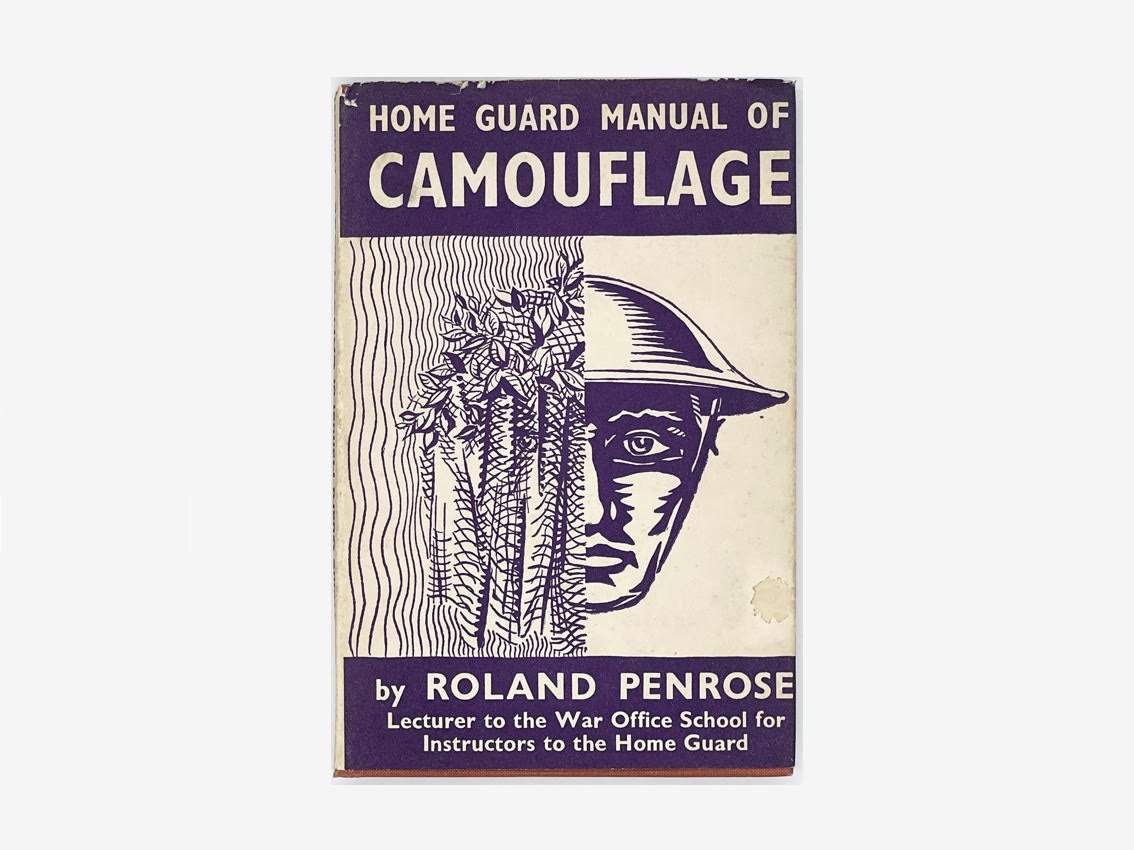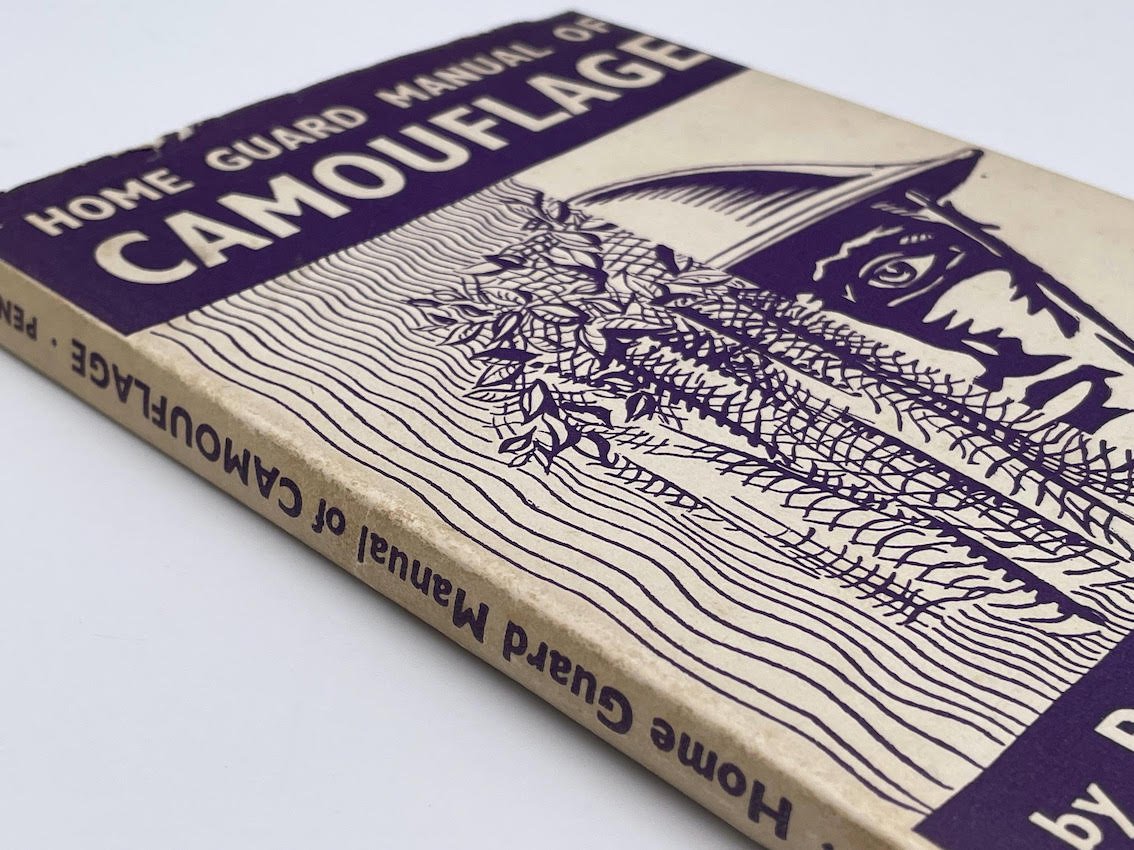Roland Penrose. Home Guard Manual of Camouflage, 1941 (First Edition)
“As a Quaker, Penrose had been a pacifist, but after the outbreak of World War II he volunteered as an air raid warden and then taught military camouflage at the Home Guard training centre at Osterley Park. This led to Penrose's commission as a captain in the Royal Engineers. He worked as senior lecturer at the Eastern Command Camouflage School in Norwich, and at the Camouflage Development and Training Centre at Farnham Castle, Surrey. During his lectures, he used to startle his audiences by inserting a colour photograph of his partner Lee Miller, lying on a lawn naked but for a camouflage net; when challenged, he argued "if camouflage can hide Lee's charms, it can hide anything". Peter Forbes (Dazzled and Deceived: Mimicry and Camouflage. Yale, 2009) suggests this was a surrealist technique being put into service. His lectures were respected by both trainees and colleagues. In 1941 Penrose wrote the Home Guard Manual of Camouflage, which provided accurate guidance on the use of texture, not only colour, especially for protection from aerial photography, which was monochrome at that time. Penrose applied for a job at the Foreign Office, but was turned down because of a perceived security risk, possibly relating to the investigation of Lee Miller by MI5.” – Text via Tate website / Wikipedia
Title: Home Guard Manual of Camouflage
Author: Roland Penrose
Publisher: George Routledge & Sons, Ltd., London
Publication date: 1941 (Second Printing October 1941)
Format: Red cloth-covered boards, black titles to spine, with illustrated dust jacket
Pages: 102pp.
Condition: Very Good. Small nicks to upper edge of dust jacket front panel, short closed tear to rear dust jacket panel, faint isolated mark to lower lower right edge of front dust jacket panel, very light spotting to rear. Otherwise a very good example of Roland Penrose’s scarce and important contribution to the war effort.
Stock Number: RB01885
“As a Quaker, Penrose had been a pacifist, but after the outbreak of World War II he volunteered as an air raid warden and then taught military camouflage at the Home Guard training centre at Osterley Park. This led to Penrose's commission as a captain in the Royal Engineers. He worked as senior lecturer at the Eastern Command Camouflage School in Norwich, and at the Camouflage Development and Training Centre at Farnham Castle, Surrey. During his lectures, he used to startle his audiences by inserting a colour photograph of his partner Lee Miller, lying on a lawn naked but for a camouflage net; when challenged, he argued "if camouflage can hide Lee's charms, it can hide anything". Peter Forbes (Dazzled and Deceived: Mimicry and Camouflage. Yale, 2009) suggests this was a surrealist technique being put into service. His lectures were respected by both trainees and colleagues. In 1941 Penrose wrote the Home Guard Manual of Camouflage, which provided accurate guidance on the use of texture, not only colour, especially for protection from aerial photography, which was monochrome at that time. Penrose applied for a job at the Foreign Office, but was turned down because of a perceived security risk, possibly relating to the investigation of Lee Miller by MI5.” – Text via Tate website / Wikipedia
Title: Home Guard Manual of Camouflage
Author: Roland Penrose
Publisher: George Routledge & Sons, Ltd., London
Publication date: 1941 (Second Printing October 1941)
Format: Red cloth-covered boards, black titles to spine, with illustrated dust jacket
Pages: 102pp.
Condition: Very Good. Small nicks to upper edge of dust jacket front panel, short closed tear to rear dust jacket panel, faint isolated mark to lower lower right edge of front dust jacket panel, very light spotting to rear. Otherwise a very good example of Roland Penrose’s scarce and important contribution to the war effort.
Stock Number: RB01885
“As a Quaker, Penrose had been a pacifist, but after the outbreak of World War II he volunteered as an air raid warden and then taught military camouflage at the Home Guard training centre at Osterley Park. This led to Penrose's commission as a captain in the Royal Engineers. He worked as senior lecturer at the Eastern Command Camouflage School in Norwich, and at the Camouflage Development and Training Centre at Farnham Castle, Surrey. During his lectures, he used to startle his audiences by inserting a colour photograph of his partner Lee Miller, lying on a lawn naked but for a camouflage net; when challenged, he argued "if camouflage can hide Lee's charms, it can hide anything". Peter Forbes (Dazzled and Deceived: Mimicry and Camouflage. Yale, 2009) suggests this was a surrealist technique being put into service. His lectures were respected by both trainees and colleagues. In 1941 Penrose wrote the Home Guard Manual of Camouflage, which provided accurate guidance on the use of texture, not only colour, especially for protection from aerial photography, which was monochrome at that time. Penrose applied for a job at the Foreign Office, but was turned down because of a perceived security risk, possibly relating to the investigation of Lee Miller by MI5.” – Text via Tate website / Wikipedia
Title: Home Guard Manual of Camouflage
Author: Roland Penrose
Publisher: George Routledge & Sons, Ltd., London
Publication date: 1941 (Second Printing October 1941)
Format: Red cloth-covered boards, black titles to spine, with illustrated dust jacket
Pages: 102pp.
Condition: Very Good. Small nicks to upper edge of dust jacket front panel, short closed tear to rear dust jacket panel, faint isolated mark to lower lower right edge of front dust jacket panel, very light spotting to rear. Otherwise a very good example of Roland Penrose’s scarce and important contribution to the war effort.
Stock Number: RB01885






















